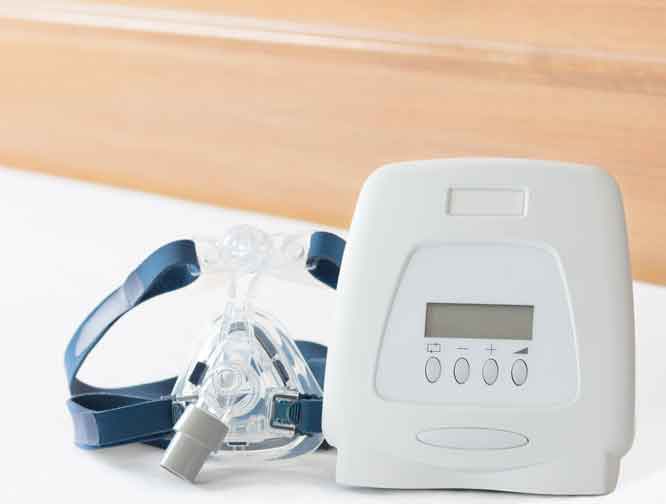 Dreamstime/TMS
Dreamstime/TMS
When untreated, OSA can negatively impact cardiac and metabolic health, quality of life, and result in excessive daytime sleepiness, insomnia, problems with thinking, and depression or anxiety. OSA impacts people of all ages, backgrounds, shapes, and sizes, and while both patients and doctors have become increasingly aware about OSA and its effects over recent years, about 80% of patients with OSA still go undiagnosed.
How is OSA diagnosed?
The severity of OSA is based on the number of respiratory sleep disruptions per hour of sleep during a sleep study, also called the apnea-hypopnea index (AHI). Basically, the higher the AHI, the more severe the sleep apnea. Most population studies suggest that about 60% of people with OSA fall into the mild category. In general, many studies demonstrate a linear relationship between the AHI and adverse health outcomes, lending strong support for treatment of moderate and severe OSA, but with less clear-cut support for clinical and/or cost-effective benefits for treating mild OSA.
Scores for OSA don't always correlate with symptoms
Regardless of the criteria for categorizing OSA as mild, moderate, or severe, the severity of disease does not always correlate with the extent of symptoms. In other words, some people with very mild disease (based on their AHI) can be extremely symptomatic, with excessive sleepiness or severe insomnia, while others with severe disease have subjectively good sleep quality and do not have significant daytime impairment.
Sleep disorders also tend to overlap, and patients with OSA may suffer from comorbid insomnia, circadian (internal body clock) disorders, sleep movement disorders (like restless legs syndrome) and/or conditions of hypersomnia (such as narcolepsy). To truly improve a patient's sleep and daytime functioning, a detailed sleep related history is needed, and sleep issues must be addressed via a comprehensive, multidimensional, and individualized approach.
Treatment approaches depend on the severity of your OSA
When sleep apnea is moderate or severe, continuous positive airway pressure (CPAP) is considered the first-line treatment, and is the recommended treatment by the American Academy of Sleep Medicine (AASM). CPAP, by eliminating snoring, breathing disturbances, and drops in oxygen saturation, can essentially normalize breathing during sleep. However, to be most beneficial, CPAP should be worn consistently throughout sleep. Unfortunately, many studies of OSA set a relatively low bar for treatment adherence (many use a four-hour-per-night threshold), and do not necessarily take into account treatment efficacy (whether sleep apnea and related daytime symptoms persist despite treatment).
What about mild sleep apnea?
There have not always been consistent outcomes data or consensus about treatment recommendations for people with mild sleep apnea. Nonetheless, there are several studies that have demonstrated quality of life benefits in treating mild OSA, including a recent study published in The Lancet, where researchers from 11 centers throughout the United Kingdom recruited and randomized 301 patients with mild OSA to receive CPAP plus standard of care (sleep hygiene counselling) vs. standard of care alone, and followed them over three months. The results found that in patients with mild OSA, treatment with CPAP improved their quality of life, based on a validated questionnaire.
This study supports a comprehensive approach to evaluation and treatment of mild OSA. While all people with mild OSA may not need to be treated with CPAP, there are patients who can greatly benefit from it.
Treatments may be trial and error until you and your doctor get it right
When sleep apnea is mild, treatment recommendations are less clear-cut, and should be determined based on the severity of your symptoms, your preferences, and other co-occurring health problems. Working in conjunction with your doctor, you can try a stepwise approach — if one treatment doesn't work, you can stop that and try an alternative. Managing mild sleep apnea involves shared decision-making between you and your doctor, and you should consider just how bothered you are by sleep apnea symptoms, as well as other components of your health that could be made worse by untreated sleep apnea.
Take-home suggestions
Conservative approaches for mild OSA:
- Maximize a side sleeping position; try not to sleep on your back.
- Optimize weight if overweight or obese; even a 5-to-10-pound weight loss can make a difference in mild OSA.
- Treat nasal allergies/congestion.
- Avoid alcohol or respiratory depressant medications close to bedtime.
- Make sure that you get an adequate amount of sleep and keep fairly regular sleep and wake times across the week.
If you have bothersome symptoms related to OSA — such as loud, disruptive snoring, long pauses in breathing, repeated nighttime awakenings, unrefreshing sleep, insomnia, trouble thinking, or excessive daytime sleepiness — or significant health problems that might be exacerbated by OSA (even mild) — such as arrhythmia, high blood pressure requiring multiple medications to control, stroke, or a severe mood disorder — medical treatment(s) for OSA should be considered.
The medical treatments for mild OSA:
- continuous positive airway pressure device (CPAP)
- a dental appliance to treat sleep apnea
- an evaluation with an ear, nose, and throat specialist (ENT), to see if there is an anatomic issue (like severe nasal septal deviation) that may be causing OSA or making it worse.
If you are concerned you might have OSA, talk to your doctor
Based on your symptoms, exam, and risk factors, your doctor may recommend a sleep study, or you might be referred to see a sleep medicine specialist. A comprehensive sleep assessment is needed to accurately evaluate sleep complaints, since sleep disorders tend to overlap. Treatment for mild OSA may improve sleep-related symptoms and your quality of life. However, there is no one-size-fits-all approach when it comes to sleep disorders, but rather a multidimensional and individualized approach to find what works for you.
(COMMENT, BELOW)


 Contact The Editor
Contact The Editor
 Articles By This Author
Articles By This Author